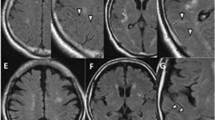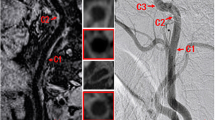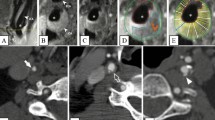Abstract
Introduction
Cilostazol, an antiplatelet agent, is reported to induce the regression of atherosclerotic changes. However, its effects on carotid plaques are unknown. Hence, we quantitatively investigated the changes that occur within carotid plaques during cilostazol administration using three-dimensional (3D) ultrasonography (US) and non-gated magnetic resonance (MR) plaque imaging.
Methods
We prospectively examined 16 consecutive patients with carotid stenosis. 3D-US and T1-weighted MR plaque imaging were performed at baseline and 6 months after initiating cilostazol therapy (200 mg/day). We measured the volume and grayscale median (GSM) of the plaques from 3D-US data. We also calculated the contrast ratio (CR) of the carotid plaque against the adjacent muscle and areas of the intraplaque components: fibrous tissue, lipid, and hemorrhage components.
Results
The plaque volume on US decreased significantly (median at baseline and 6 months, 0.23 and 0.21 cm3, respectively; p = 0.03). In the group exhibiting a plaque volume reduction of more than 10%, GSM on US increased significantly (24.8 and 71.5, respectively; p = 0.04) and CR on MRI decreased significantly (1.13 and 1.04, respectively; p = 0.02). In this group, in addition, the percent area of the fibrous component on MRI increased significantly (68.6% and 79.4%, respectively; p = 0.02), while those of the lipid and hemorrhagic components decreased (24.9% and 20.5%, respectively; p = 0.12) (1.0% and 0.0%, respectively; p = 0.04). There were no substantial changes in intraplaque characteristics in either US or MRI in the other group.
Conclusions
3D-US and MR plaque imaging can quantitatively detect changes in the size and composition of carotid plaques during cilostazol therapy.



Similar content being viewed by others
References
Uchiyama S, Demaerschalk BM, Goto S, Shinohara Y, Gotoh F, Stone WM, Money SR, Kwon SU (2009) Stroke prevention by cilostazol in patients with atherothrombosis: meta-analysis of placebo-controlled randomized trials. J Stroke Cerebrovasc Dis 18(6):482–490. doi:10.1016/j.jstrokecerebrovasdis.2009.07.010
Shinohara Y, Katayama Y, Uchiyama S, Yamaguchi T, Handa S, Matsuoka K, Ohashi Y, Tanahashi N, Yamamoto H, Genka C, Kitagawa Y, Kusuoka H, Nishimaru K, Tsushima M, Koretsune Y, Sawada T, Hamada C (2010) Cilostazol for prevention of secondary stroke (CSPS 2): an aspirin-controlled, double-blind, randomized non-inferiority trial. Lancet Neurol 9:959–968. doi:10.1016/S1474-4422(10)70198-8
Katakami N, Kim YS, Kawamori R, Yamasaki Y (2010) The phosphodiesterase inhibitor cilostazol induces regression of carotid atherosclerosis in subjects with type 2 diabetes mellitus: principal results of the Diabetic Atherosclerosis Prevention by Cilostazol (DAPC) study: a randomized trial. Circulation 121:2584–2591. doi:10.1161/CIRCULATIONAHA.109.892414
Takeda M, Yamashita T, Shinohara M, Sasaki N, Tawa H, Nakajima K, Momose A, Hirata KI (2011) Beneficial effect of anti-platelet therapies on atherosclerotic lesion formation assessed by phase-contrast X-ray CT imaging. Int J Cardiovasc Imaging. doi:10.1007/s10554-011-9910-6
Lee JH, Oh GT, Park SY, Choi JH, Park JG, Kim CD, Lee WS, Rhim BY, Shin YW, Hong KW (2005) Cilostazol reduces atherosclerosis by inhibition of superoxide and tumor necrosis factor-alpha formation in low-density lipoprotein receptor-null mice fed high cholesterol. J Pharmacol Exp Ther 313:502–509
Nakaya K, Ayaori M, Uto-Kondo H, Hisada T, Ogura M, Yakushiji E, Takiguchi S, Terao Y, Ozasa H, Sasaki M, Komatsu T, Ohsuzu F, Ikewaki K (2010) Cilostazol enhances macrophage reverse cholesterol transport in vitro and in vivo. Atherosclerosis 213:135–141. doi:10.1016/j.atherosclerosis.2010.07.024
Iba T, Kidokoro A, Fukunaga M, Takuhiro K, Ouchi M, Ito Y (2006) Comparison of the protective effects of type III phosphodiesterase (PDE3) inhibitor (cilostazol) and acetylsalicylic acid on intestinal microcirculation after ischemia reperfusion injury in mice. Shock 26:522–526. doi:10.1097/01.shk.0000228800.56223.db
Otsuki M, Saito H, Xu X, Sumitani S, Kouhara H, Kurabayashi M, Kasayama S (2001) Cilostazol represses vascular cell adhesion molecule-1 gene transcription via inhibiting NF-kappaB binding to its recognition sequence. Atherosclerosis 158:121–128
Kwon SU, Cho YJ, Koo JS, Bae HJ, Lee YS, Hong KS, Lee JH, Kim JS (2005) Cilostazol prevents the progression of the symptomatic intracranial arterial stenosis: the multicenter double-blind placebo-controlled trial of cilostazol in symptomatic intracranial arterial stenosis. Stroke 36:782–786. doi:10.1161/01.STR.0000157667.06542.b7
Pipe JG (1999) Motion correction with PROPELLER MRI: application to head motion and free-breathing cardiac imaging. Magn Reson Med 42:963–969
Narumi S, Sasaki M, Ohba H, Ogasawara K, Hitomi J, Mori K, Ohura K, Ono A, Terayama Y (2010) Altered carotid plaque signal among different repetition times on T1-weighted magnetic resonance plaque imaging with self-navigated radial-scan technique. Neuroradiology 52:285–290. doi:10.1007/s00234-009-0642-4
Sabetai MM, Tegos TJ, Nicolaides AN, Dhanjil S, Pare GJ, Stevens JM (2000) Reproducibility of computer-quantified carotid plaque echogenicity: can we overcome the subjectivity? Stroke 31:2189–2196
Sztajzel R, Momjian-Mayor I, Comelli M, Momjian S (2006) Correlation of cerebrovascular symptoms and microembolic signals with the stratified gray-scale median analysis and color mapping of the carotid plaque. Stroke 37:824–829. doi:10.1161/01.STR.0000204277.86466.f0
Makris GC, Lavida A, Nicolaides AN, Geroulakos G (2010) The effect of statins on carotid plaque morphology: a LDL-associated action or one more pleiotropic effect of statins? Atherosclerosis 213:8–20. doi:10.1016/j.atherosclerosis.2010.04.032
Takaya N, Yuan C, Chu B, Saam T, Underhill H, Cai J, Tran N, Polissar NL, Isaac C, Ferguson MS, Garden GA, Cramer SC, Maravilla KR, Hashimoto B, Hatsukami TS (2006) Association between carotid plaque characteristics and subsequent ischemic cerebrovascular events: a prospective assessment with MRI—initial results. Stroke 37:818–823. doi:10.1161/01.STR.0000204638.91099.91
Yoshida K, Narumi O, Chin M, Inoue K, Tabuchi T, Oda K, Nagayama M, Egawa N, Hojo M, Goto Y, Watanabe Y, Yamagata S (2008) Characterization of carotid atherosclerosis and detection of soft plaque with use of black-blood MR imaging. AJNR Am J Neuroradiol 29:868–874. doi:10.3174/ajnr.A1015
Vicenzini E, Giannoni MF, Puccinelli F, Ricciardi MC, Altieri M, Di Piero V, Gossetti B, Valentini FB, Lenzi GL (2007) Detection of carotid adventitial vasa vasorum and plaque vascularization with ultrasound cadence contrast pulse sequencing technique and echo-contrast agent. Stroke 38:2841–2843. doi:10.1161/STROKEAHA.107.48791818
Unger EC, Cohen MS, Brown TR (1989) Gradient-echo imaging of hemorrhage at 1.5 Tesla. Magn Reson Imaging 7:163–172
Lee YS, Kwon ST, Kim JO, Choi ES (2011) Serial MR imaging of intramuscular hematoma: experimental study in a rat model with the pathologic correlation. Korean J Radiol 12:66–77. doi:10.3348/kjr.2011.12.1.66
Kullmer K, Sievers KW, Rompe JD, Nagele M, Harland U (1997) Sonography and MRI of experimental muscle injuries. Arch Orthop Trauma Surg 116:357–361
Acknowledgements
This work was partly supported by a Grant-in-Aid for Strategic Medical Science Research and Grants-in-Aid for Science Research (22890169, 22590963) from the Ministry of Education, Culture, Sports, Science and Technology of Japan, and by a Research Grant for Cardiovascular Diseases (20C-1) from the Ministry of Heath, Labor and Welfare of Japan.
Conflict of interest
MS has served as a consultant for Hitachi Medical Corporation and has received honoraria for lectures from Hitachi Medical Corporation, GE Healthcare, and Otsuka Pharmaceutical Corporation.
Author information
Authors and Affiliations
Corresponding author
Rights and permissions
About this article
Cite this article
Yamaguchi, M., Sasaki, M., Ohba, H. et al. Quantitative assessment of changes in carotid plaques during cilostazol administration using three-dimensional ultrasonography and non-gated magnetic resonance plaque imaging. Neuroradiology 54, 939–945 (2012). https://doi.org/10.1007/s00234-012-1011-2
Received:
Accepted:
Published:
Issue Date:
DOI: https://doi.org/10.1007/s00234-012-1011-2




